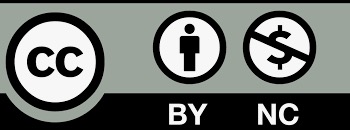Published
2025-03-29
Section
Research Articles
License
Copyright (c) 2025 Jinglin Chi, Syafila Kamarudin

This work is licensed under a Creative Commons Attribution-NonCommercial 4.0 International License.
The journal adopts the Attribution-NonCommercial 4.0 International (CC BY-NC 4.0), which means that anyone can reuse and redistribute the materials for non-commercial purposes as long as you follow the license terms and the original source is properly cited.
Author(s) shall retain the copyright of their work and grant the Journal/Publisher rights for the first publication with the work concurrently licensed since 2023 Vol.8 No.2.
Under this license, author(s) will allow third parties to download, reuse, reprint, modify, distribute and/or copy the content under the condition that the authors are given credit. No permission is required from the authors or the publisher.
This broad license intends to facilitate free access, as well as the unrestricted use of original works of all types. This ensures that the published work is freely and openly available in perpetuity.
By providing open access, the following benefits are brought about:
- Higher Visibility, Availability and Citations-free and unlimited accessibility of the publication over the internet without any restrictions increases citation of the article.
- Ease of search-publications are easily searchable in search engines and indexing databases.
- Rapid Publication – accepted papers are immediately published online.
- Available for free download immediately after publication at https://esp.as-pub.com/index.php/ESP

Copyright Statement
1.The authors certify that the submitted manuscripts are original works, do not infringe the rights of others, are free from academic misconduct and confidentiality issues, and that there are no disputes over the authorship scheme of the collaborative articles. In case of infringement, academic misconduct and confidentiality issues, as well as disputes over the authorship scheme, all responsibilities will be borne by the authors.
2. The author agrees to grant the Editorial Office of Environment and Social Psychology a licence to use the reproduction right, distribution right, information network dissemination right, performance right, translation right, and compilation right of the submitted manuscript, including the work as a whole, as well as the diagrams, tables, abstracts, and any other parts that can be extracted from the work and used in accordance with the characteristics of the journal. The Editorial Board of Environment and Social Psychology has the right to use and sub-licence the above mentioned works for wide dissemination in print, electronic and online versions, and, in accordance with the characteristics of the periodical, for the period of legal protection of the property right of the copyright in the work, and for the territorial scope of the work throughout the world.
3. The authors are entitled to the copyright of their works under the relevant laws of Singapore, provided that they do not exercise their rights in a manner prejudicial to the interests of the Journal.
About Licence
Environment and Social Psychology is an open access journal and all published work is available under the Creative Commons Licence, Authors shall retain copyright of their work and grant the journal/publisher the right of first publication, and their work shall be licensed under the Attribution-NonCommercial 4.0 International (CC BY-NC 4.0).
Under this licence, the author grants permission to third parties to download, reuse, reprint, modify, distribute and/or copy the content with attribution to the author. No permission from the author or publisher is required.
This broad licence is intended to facilitate free access to and unrestricted use of original works of all kinds. This ensures that published works remain free and accessible in perpetuity. Submitted manuscripts, once accepted, are immediately available to the public and permanently accessible free of charge on the journal’s official website (https://esp.as-pub.com/index.php/ESP). Allowing users to read, download, copy, print, search for or link to the full text of the article, or use it for other legal purposes. However, the use of the work must retain the author's signature, be limited to non-commercial purposes, and not be interpretative.
Click to download <Agreement on the Licence for the Use of Copyright on Environmental and Social Psychology>.
How to Cite
Selective exposure in the digital age: A systematic review of the mechanisms, contexts, and sociopsychology implications for media ecosystems(2013-2023)
Jinglin Chi
Syafila Kamarudin, Institute for Social Science Studies, Putra Infoport, Universiti Putra Malaysia, 43400 UPM Serdang, Selangor, Malaysia
Syafila Kamarudin
Syafila Kamarudin, Institute for Social Science Studies, Putra Infoport, Universiti Putra Malaysia, 43400 UPM Serdang, Selangor, Malaysia 2Syafila Kamarudin, Institute for Social Science Studies, Putra Infoport, Universiti Putra Malaysia, 43400 UPM Serdang, Selangor, Malaysia
DOI: https://doi.org/10.59429/esp.v10i3.3487
Keywords: PRISMA; selective exposure; social media; cognitive dissonance
Abstract
Selective exposure is a complex phenomenon, and this study takes a systematic approach to reviewing its manifestations in the changing environment of new media. Following the PRISMA guidelines, a systematic review process was carried out across various databases and found 20 scholarly articles from Google Scholar, ProQuest, CNKI and Scopus for detailed analysis. This analysis, in turn, investigates the contextual evolution, motivational underpinnings, and consequences of selective exposure on both individual and societal behavior.
The findings capture important transitions from conventional online spaces to algorithmically-modulated social media settings, extending the focus from politics to a wider range of public topics including health and environmental communication. Consequently, the framework suggests the interaction of cognitive dissonance, group dynamics, and technology as motivational drivers of selective exposure, highlighting the conclusion that selective exposure is the result of influences by the individual as an agent, their group affiliations, and structures. Take selective exposure as both an independent and dependent variable for inclusion within conceptual frameworks is identified, and its role as a mediating and moderating variable is identified reflecting both theoretical suitability and empirical importance. In addition to solidifying similar narratives through action and interaction, findings also suggest modes of engagement with alternate information sources—reflecting both negative consequences for agreement but potential for constructive debate—highlighting complex impacts of selective exposure across both media consumption and a more polarized society.
This study shows the relevance of selective exposure research for the understanding of media behaviors, cognitive processes, and sociopolitical dynamics for future research as well its implications as sensitive to media literacy programs and policy interventions. Further, future research would benefit from interdisciplinary approaches and adaptive methodologies to grapple with the challenges of selective exposure in polarized, technology-driven media ecosystems. This review also aim to advance theory, inform policy, and create a more egalitarian and equitable digital information ecosystem.
References
[1]. 1.Bennett, W. L., & Segerberg, A. (2011). Digital media and the personalization of collective action: Social technology and the organization of protests against the global economic crisis. Information, Communication & Society, 14(6), 770–799.
[2]. 2.Alzubi, A. (2023). The evolving relationship between digital and conventional media: A study of media consumption habits in the digital era. The Progress: A Journal of Multidisciplinary Studies, 4(3), 1–13.
[3]. 3.Monzer, C., Moeller, J., Helberger, N., & Eskens, S. (2020). User perspectives on the news personalisation process: Agency, trust and utility as building blocks. Digital Journalism, 8(9), 1142–1162.
[4]. 4.Kozyreva, A., Lewandowsky, S., & Hertwig, R. (2020). Citizens versus the internet: Confronting digital challenges with cognitive tools. Psychological Science in the Public Interest, 21(3), 103–156.
[5]. 5.Feldman, L., & Hart, P. S. (2018). Broadening exposure to climate change news? How framing and political orientation interact to influence selective exposure. Journal of Communication, 68(3), 503–524.
[6]. 6.Khalid, L. (2024). Political polarization in the digital age: A psychological examination. Journal for Current Sign, 2(2), 83–96.
[7]. 7.Raza, N. (2023). Unraveling the nexus: Exploring the relationship between social media and political polarization. Law Research Journal, 1(2), 64–72.
[8]. 8.Dylko, I. B. (2016). How technology encourages political selective exposure. Communication Theory, 26(4), 389–409.
[9]. 9.Knobloch-Westerwick, S., Johnson, B. K., & Westerwick, A. (2013). To your health: Self-regulation of health behavior through selective exposure to online health messages. Journal of Communication, 63(5), 807–829.
[10]. 10.Spohr, D. (2017). Fake news and ideological polarization: Filter bubbles and selective exposure on social media. Business Information Review, 34(3), 150–160.
[11]. 11.Cardenal, A. S., Aguilar-Paredes, C., Galais, C., & Pérez-Montoro, M. (2019). Digital technologies and selective exposure: How choice and filter bubbles shape news media exposure. The International Journal of Press/Politics, 24(4), 465–486.
[12]. 12.Elmore, S., Meyers, C., Fischer, L. M., Burris, S., & McCord, A. (2023). Time well spent: Exploring the role of attitude and topic importance on selective exposure to agricultural messages. Journal of Applied Communications, 107(1), 3.
[13]. 13.Frauhammer, L. T., & Neubaum, G. (2024). The effects of climate change meta-knowledge on selective exposure, selective elaboration, and behavioral intentions. Science Communication. https://doi.org/10.1177/10755470241284938
[14]. 14.Van Aelst, P., Strömbäck, J., Aalberg, T., Esser, F., De Vreese, C., Matthes, J., ... & Stanyer, J. (2017). Political communication in a high-choice media environment: A challenge for democracy? Annals of the International Communication Association, 41(1), 3–27.
[15]. 15.Hanitzsch, T., & Vos, T. P. (2018). Journalism beyond democracy: A new look into journalistic roles in political and everyday life. Journalism, 19(2), 146–164.
[16]. 16.Moher, D., Liberati, A., Tetzlaff, J., Altman, D. G., & PRISMA Group. (2009). Preferred reporting items for systematic reviews and meta-analyses: The PRISMA statement. Annals of Internal Medicine, 151(4), 264–269.
[17]. 17.Sierra-Correa, P. C., & Kintz, J. R. C. (2015). Ecosystem-based adaptation for improving coastal planning for sea-level rise: A systematic review for mangrove coasts. Marine Policy, 51, 385–393.
[18]. 18.Chi, J., Kamarudin, S., & Rahman, S. N. A. (2024). Shaping governance through social media: A review of Chinese government strategies and public engagement (2013–2023). Unpublished manuscript.
[19]. 19.Pluye, P., Gagnon, M. P., Griffiths, F., & Johnson-Lafleur, J. (2009). A scoring system for appraising mixed methods research, and concomitantly appraising qualitative, quantitative and mixed methods primary studies in mixed studies reviews. International Journal of Nursing Studies, 46(4), 529–546.
[20]. 20.Tang, L., Omar, S. Z., Bolong, J., & Mohd Zawawi, J. W. (2021). Social media use among young people in China: A systematic literature review. SAGE Open, 11(2), 21582440211016421.
[21]. 21.Wang, H., & Cai, T. (2018). Media exposure and Chinese college students’ attitudes toward China’s maritime claims and disputes in the South and East China Seas. Cogent Social Sciences, 4(1), 1482995.
[22]. 22.Liu, Y., & Liao, Z. (2022). How do people choose political information? A study of selective exposure theory from the perspective of political communication [How do people select political information? ——Selective contact theory from the perspective of political communication]. Peking University Political Science Review [Peking University Political Science Review], 2022(1), 228–253.
[23]. 23.Yan, Q. H. (2020). Duality and interconstruction: The influence of selective exposure on youth online political expression [Duality interconstruction: Youth online political opinion expression under the influence of selective contact]. Xinwen Daxue [News University], 2020(3), 15–22.
[24]. 24.Weeks, B. E., Lane, D. S., Kim, D. H., Lee, S. S., & Kwak, N. (2017). Incidental exposure, selective exposure, and political information sharing: Integrating online exposure patterns and expression on social media. Journal of Computer-Mediated Communication, 22(6), 363–379.
[25]. 25.Velasquez, A., Montgomery, G., & Hall, J. A. (2019). Ethnic minorities’ social media political use: How ingroup identification, selective exposure, and collective efficacy shape social media political expression. Journal of Computer-Mediated Communication, 24(4), 147–164.
[26]. 26.Aruguete, N., & Calvo, E. (2018). Time to# protest: Selective exposure, cascading activation, and framing in social media. Journal of Communication, 68(3), 480–502.
[27]. 27.Tsang, J. S. (2019). Cognitive discrepancy, dissonance, and selective exposure. Media Psychology, 22(3), 394–417.
[28]. 28.Zhu, Q., Weeks, B. E., & Kwak, N. (2024). Implications of online incidental and selective exposure for political emotions: Affective polarization during elections. New Media & Society, 26(1), 450–472.
[29]. 29.Rabb, N., Cowen, A., & de Ruiter, L. (2023). Selective exposure and affective polarization: A dynamic media perspective. Media Psychology, 26(2), 145–162.
[30]. 30.Hasanuddin, F. A., Akbar, M., & Farid, M. (2022, November). Analysis of selective exposure cluster in the Covid-19 vaccine information network on Twitter. In International Conference on Communication, Policy and Social Science (InCCluSi 2022) (pp. 454–465). Atlantis Press.







